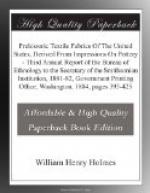Examples of this kind of weaving may be obtained from the fictile remains of nearly all the Atlantic States.
The specimen presented in Fig. 64 was obtained from a small fragment of ancient pottery from the State of New York.
[Illustration: Fig. 64.—Fabric
impressed upon ancient pottery, New
York.]
It is generally quite difficult to determine which set of threads is the warp and which the woof. In most cases I have preferred to call the more closely placed threads the woof, as they are readily beaten down by a baton, whereas it would be difficult to manipulate the warp threads if so closely placed. In the specimen illustrated, only the tightly woven threads of the woof appear. The impression is not sufficiently distinct to show the exact character of the thread, but there are indications that it has been twisted. The regularity and prominence of the ridges indicate a strong, tightly drawn warp.
Fig. 65 represents a form of this type of fabric very common in impressions upon the pottery of the Middle Atlantic States. This specimen was obtained from a small potsherd picked up near Washington, D.C. The woof or cross-threads are small and uniform in thickness, and pass alternately over and under the somewhat rigid fillets of the web. The apparent rigidity of these fillets may result from the tightening of the series when the fabric was applied to the plastic surface of the vessel.
[Illustration: Fig. 65.—From
a fragment of ancient pottery,
District of Columbia.]
I present in Fig. 66 the only example of the impression of a woven fabric found by the writer in two summers’ work among the remains of the ancient Cliff-Dwellers. It was obtained from the banks of the San Juan River, in southeastern Utah. It is probably the imprint of the interior surface of a more or less rigid basket, such as are to be seen among many of the modern tribes of the Southwest. The character of the warp cannot be determined, as the woof, which has been of moderately heavy rushes or other untwisted, vegetable fillets, entirely hides it.
[Illustration: Fig. 66.—From
a fragment of ancient Cliff-house
pottery.]
The caves of Kentucky have furnished specimens of ancient weaving of much interest. One of these, a small fragment of a mat apparently made from the fiber of bark, or a fibrous rush, is illustrated in Fig. 67.
[Illustration: Fig. 67.—Fabric from a cave in Kentucky.]
This simple combination of the web and woof has been employed by all ancient weavers who have left us examples of their work. The specimen given in Fig. 68 is the work of the ancient Lake-Dwellers of Switzerland. It is a mat plaited or woven of strips of bast, and was found at Robenhausen, having been preserved in a charred state.[2] Keller gives another example of a similar fabric of much finer texture in Fig. 8, Pl. CXXXVI.
[Illustration: Fig. 68.—Fabric from Swiss Lake-Dwellings.]




